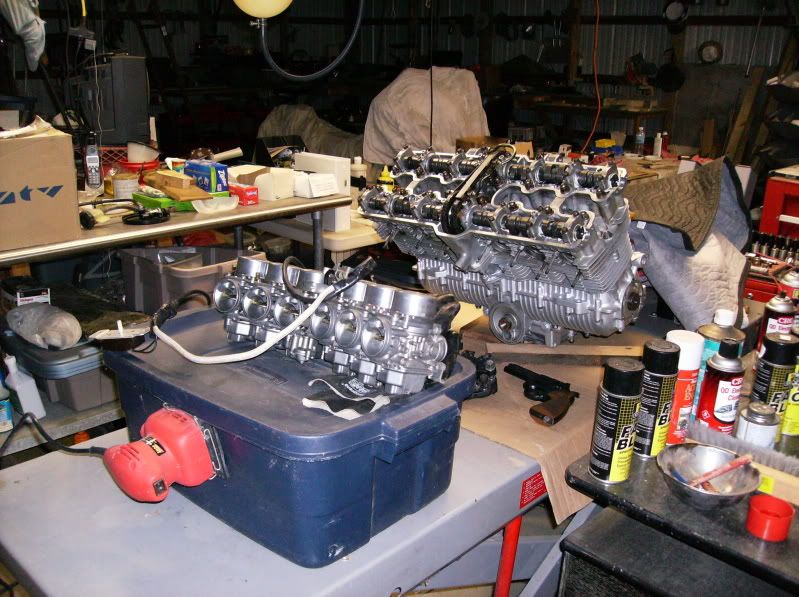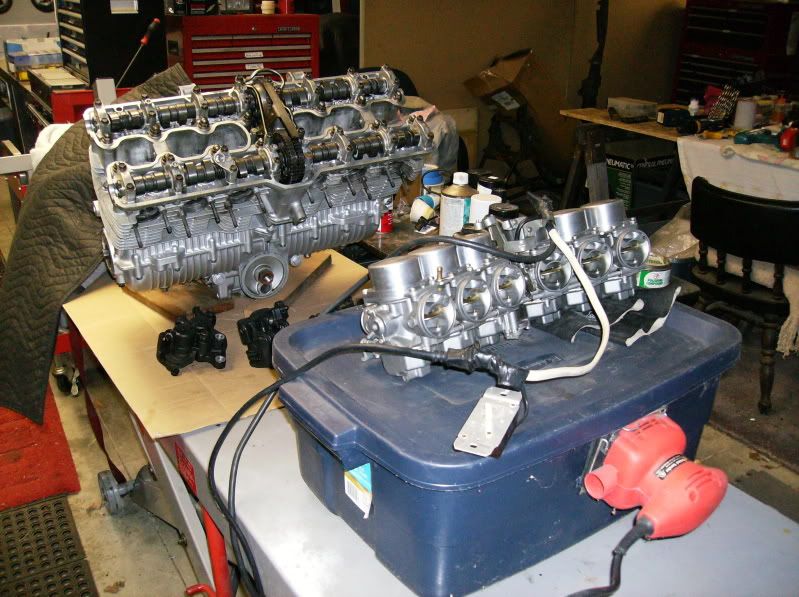I've finally got my 80 running right!


When I bought it 5 months ago it would hesitate and misfire from idle to 4K which I figured was either carbs or electrical. The wise ones on the forum told me it was carbs but with past experience in wrenching limited to old brit bikes the thought of tilting an engine and dealing with 6 carbs was a bit intimidating to say the least. So with that in mind I tackled the easy stuff first. I replaced the pulsar as one of the elctrodes had worn down to the block. Replaced plug caps and wires as 2 of the old ones would shock me if I touched them when wet. Replaced a cracked coil and replaced my K&N air filter with a paper one. I adjusted the valves and made sure the compression was equel across all 6 cylinders. Result, no change.
So with the manual out I set about tilting the engine and removing the carbs. First time took me 6 hours

(Having done this 7 times now I can have the carbs on the bench in 44 minutes. Whats your personal best? :) )
I had bought Mike Nixons carb book which really steps you through the whole cleaning process which I followed to the "T" or so I thought. Put the carbs back on and while it was better it was still not right. Took them off, cleaned again and removed idle jets but still no joy. Did it one more time and replaced idle jets, still the same.

At this point I had a 3 month e-mail thread going with Mike Nixon and had also begun talking with Dave McMunn by phone. If this was not enough help on my way down to Daytona I stopped off to see Louis and he introduced me to Preston Marks who was good enough to give me a carb lesson in his work shop.
I was beginning to think I might not have set my float levels correctly. Off with the carbs again.
Here's the punch line:
The hesitation was due to only 3 accelerator jets working. While I shot carb cleaner through them just like it says in Mikes book they somehow got blocked again so when I snapped the throttle I only got half the cylinders sucking in the extra fuel.
The misfire was because I had the float levels too low creating a lean condition. I was not aware of the compressable plunger at the top of the float needle so when I set the float level to 15.5mm I was partially compressing the plunger. Of course when I removed the float level tool the plunger pushed the float down into a low position. OK for the main jet but too low for the idle jet to get a good flow.
Here's a picture of #6 float incorrectly set. Look at the angle of the float tab and how it is compressing the plunger.

This is a picture of the float needles with the plunger being that little pin at the top. The needle on the left is aftermarket the one on the right an original Honda.

This is a float correctly set with the float tab just touching the plunger.

As per Mike Nixon's book measure with the carbs the right way up.

Check the carbs for leaks. Hook up to your tank and blow into the long tube that comes off the vacuum valve to let the fuel flow. Do this before putting the carbs back on the bike or you will have to take them off again...........been there done that.

Once I had the float levels right there was an instant transformation. It started good and ran smooth to the red line. The misfire was 90% better but I could still feel a little. Dave suggested checking the fuel level using a tube attached to the drain bowl.
Here's a picture of of the fuel level just at the top of the right most screw that attaches the carb to the frame. 1, 2, 3, 5 & 6 were all the same.

This the level of #4 which was below the screw.

So off with the bowl and a little tweak and it was at the same level.
Last thing I did was sync the carbs again. Previously I had removed the gauge faces and with the adjustment screw set all the needles to the same dial position. With the bike idling I adjusted the carbs all to the same level but found if I switched vacuum tubes the readings would change. Having the needles all point to the same number does not mean they are baselined. The way I did it was to attach one of the vacuum tube extensions to #6 carb and attach each guage in turn adjusting the needle to point to the same place. This way you know every gauge is reading the same at a given vacuum.
During this process Dave was kind enough to lend me a set of carbs to compare. This helped no end as I was able to put them on and see how my bike was supposed to run. When I made a change to my carbs I could run them and if they did not seem quite right I could quickly replace them with Daves to confirm.
Early on I found #2 was running hotter at the header than the other 5 by 30F. Today it only runs 20F hotter. Mike told me that you get variations like this and by trying Dave's carbs nothing changed so he was right.
Thanks to all of you who have posted suggestions on this and my other threads. I would not have figured this out without all of the help you have given. Special thanks to Mike, Dave and Preston who shared their knowledge and kept up with my never ending questions.
Ross





